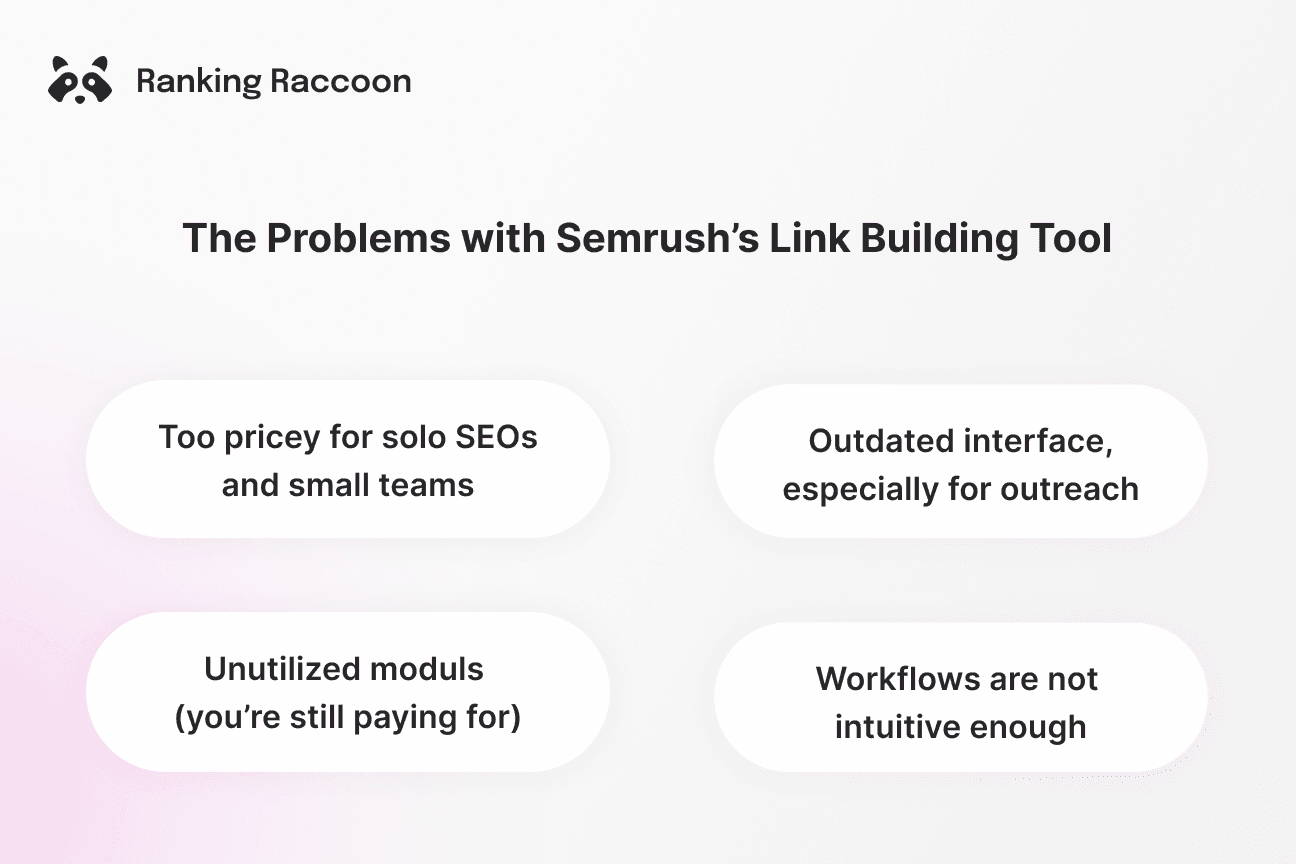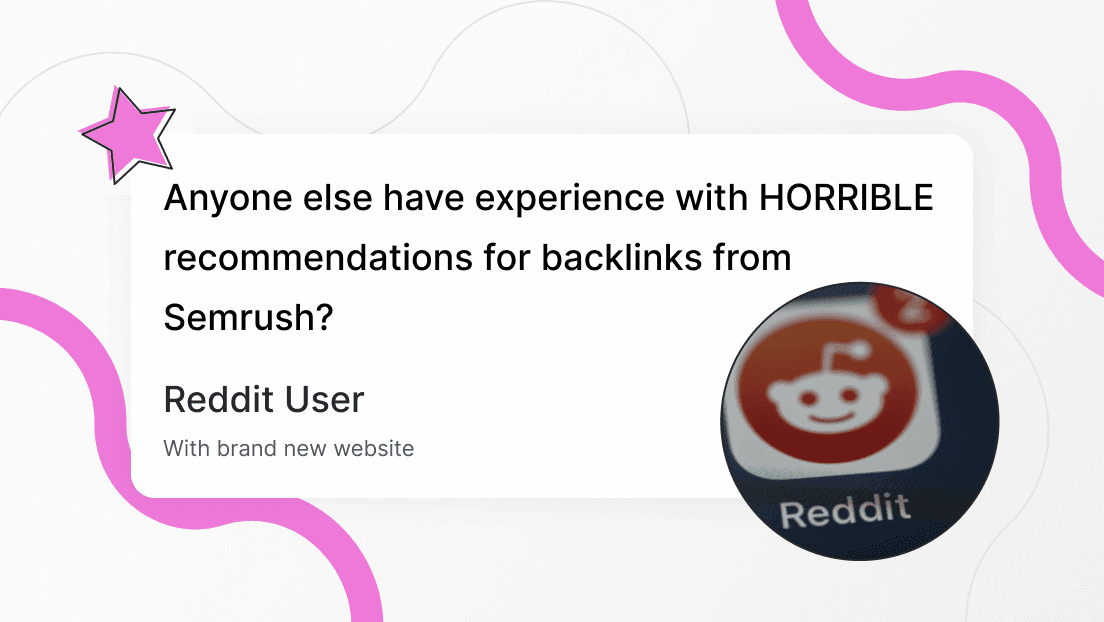What is the Best Semrush Alternative for Link Building?

Eliza Forgacs
If you’re reading this, chances are you’re frustrated. Maybe Semrush feels overpriced, overly bloated, or just doesn’t quite match your workflow. Or perhaps you want a streamlined tool that does link building well—without forcing you to wade through dashboards for PPC, content, social, and everything else. You want a semrush alternative that is sharp, effective, and more human. Let’s dig in.

Why Leave Semrush for Link Building?
Semrush is powerful. It’s one of the heavyweights in SEO toolkits. But heavy can also mean clunky, costly, and overkill in parts. Some common complaints:
- The cost for full access (all modules) can be prohibitive for small teams or solo SEOs.
- The interface and workflows sometimes feel dated or awkward, especially for link outreach.
- You may never use many of its modules (PPC, social, etc.) but still pay for them.
- Some users find that key workflows—like prospecting by custom keywords or using templates—are less intuitive than they should be.
In short: yes, Semrush can do nearly everything. But in the process, it may dilute the actual “link building experience.” The smarter approach is to aim for less friction—fewer tools to juggle, fewer wasted steps, and more direct results.
But first, we need to see how good Semrush really is in the link building domain, and then compare it to the alternatives.
Semrush Link Building Tool: An Honest Review
What is the Link Building Tool in Semrush?
Semrush’s Link Building Tool is a module designed to let you prospect for backlink opportunities, manage outreach, and track link acquisition progress without hopping between multiple apps. Backlinko frames it as a way to reduce context-switching:

Semrush itself describes its prospecting as based on target keywords, industry connections, and competitor backlinks among other signals. You set up the tool by feeding it with your site (or a target domain) and keywords, and Semrush surfaces potential linking sites.
Semrush Link Building Tool Features
Here’s a breakdown of what Semrush’s Link Building Tool actually does—and what happens when you kick the tires a little too hard. (Yes, the Raccoon did some paw-on testing.)
Prospecting That Feels Restrictive
Semrush generates lists of prospects by analyzing competitor backlinks, keywords, and topical relevance. In theory, this sounds neat—you type in what you want, and voilà: potential link targets. In practice, however, this keyword-based prospecting can feel clunky. You can’t always enter your own custom keywords freely; instead, you’re stuck with dropdowns or “advanced filters.” That’s like giving a raccoon a buffet menu but only letting it order from the kids’ section.
Outreach That Caps Your Efforts
Semrush lets you send outreach emails directly inside the platform, build templates, and track whether they’re sent, opened, or replied to. This is genuinely useful, but the interface feels like it hasn’t had coffee since 2016. Daily send limits (around 500 emails) are enforced, and customization options are… let’s say, minimalist. If you’re expecting AI-assisted draft generation like newer tools provide, you’ll be disappointed—you’re on your own.
Monitoring That Still Needs Backup
Credit where it’s due: Semrush does a solid job tracking whether your hard-won backlinks are still alive. It can alert you when links vanish and connects with its backlink audit modules. That said, no tool is flawless—many SEOs still double-check with Ahrefs or Majestic.
“Toxicity” Filters That Need Human Judgment
Semrush assigns authority scores and flags “toxic” backlinks, helping you filter out low-quality prospects. Handy for disavow files, yes—but the toxicity algorithm can be overly cautious or, at times, miss real threats. In other words, don’t blindly outsource your judgment to a green/red traffic light. Even raccoons know when a meal is rotten.
Reporting That Lacks Flexibility
Built-in dashboards summarize how many emails you’ve sent, who replied, and what links you’ve gained. The reporting is fine for quick overviews, but if you’re the type who loves hyper-customized dashboards, prepare for some frustration and extra work.
Integrations That Don’t Always Deliver
You can hook up your own email account (via SMTP) so all outreach is tracked. Convenient—until setup gets tricky or deliverability gremlins creep in. If your domain reputation is shaky, Semrush won’t magically save you from the spam folder.
Bottom line: Semrush’s Link Building Tool has all the right checkboxes—prospecting, outreach, monitoring, reporting—but each comes with a few caveats. It’s not that the tool is bad; it’s that it feels like it hasn’t fully kept pace with how modern link building and outreach actually happen.
A Reddit User's take on link building tools:
"The most successful agencies aren't using tools - they are building relationships. With other marketing agencies, with website owners, with the various different people and organizations needed to ensure they get good value for the links they request."
Read the full discussion here.
How to build links with Semrush?
Semrush structures link building as a step-by-step pipeline. The process is fairly standardized and looks something like this:
- Set up your campaign / project, input your domain and select target keywords.
- Generate prospect list via competitor link intersections, keyword relevance, or niche topical filters.
- Review prospects to identify low-hanging fruit.
- Add prospects to the outreach queue. You can filter, sort, and discard irrelevant items.
- Craft outreach emails using templates, customize, add follow-ups.
- Send outreach, track opens, responses, and convert prospects into links.
- Monitor the acquired links—Semrush will periodically check if links still exist or have changed.
- Audit link profile to find toxic or low-quality links and possibly disavow them.
It’s a closed-loop system, but again, in practice, many users still cross-check prospects or link statuses with external tools.

What Is Missing: The Weak Spots of Semrush
Now, let’s be honest: Semrush’s Link Building Tool checks most of the boxes, but once you scratch beneath the convincing “all-in-one” label, the cracks start showing.
- Custom keyword flexibility is limited.
You can enter a handful of keywords, but if you’re working in a micro-niche, the tool tends to push you toward its own suggestions. It’s a bit like asking for organic avocados at the store and being handed frozen peas because “it’s all green.”
- Functional, but frustrating outreach.
Semrush’s outreach module technically gets the job done, but daily caps, patchy integrations, and an outdated interface make it feel more like a stopgap than a long-term solution. For serious link building at scale, dedicated outreach platforms still have the upper hand.
- Prospect quality is hit-or-miss.
Some suggestions are great; others look like they were pulled straight from the basement of the internet (hello, Russian movie blogs). If you’re in a niche industry, expect more misses than hits.
- The all-in-one trade-off:
It’s convenient to have prospecting, outreach, monitoring, and reporting in one place. But convenience comes at the cost of specialization. Semrush will get you “good enough” at everything, but rarely “best in class” at any one thing.
Mini Case Study: When Semrush Went to the Wrong Party
One Redditor (running a brand-new niche site) tried using the Semrush Link Building Tool to discover backlink prospects. The tool, full of confidence, recommended a dazzling list of opportunities… which turned out to include:
- dead websites,
- irrelevant Russian portals,
- and even a Mexican movie blog.
Not exactly the crème de la crème of link building. The user’s verdict? The tool provided “almost zero useful data.”
This is a textbook example of the prospect quality problem: for established, mainstream industries, Semrush’s database is strong. But in smaller niches or with new domains, the “recommendations” can feel more like drawing names from a hat at a raccoon family reunion.

What Is the Best Alternative to Semrush?
To find an alternative to Semrush that’s strong in link building, we should look at tools that specialize in or excel at outreach, prospecting, or campaign workflow. Here are some notable contenders:
1. Ranking Raccoon
- Ranking Raccoon is a relatively new player that focuses on simplifying the entire link building workflow. Unlike many single-purpose tools, it combines prospecting and outreach in one place—with AI assistance to speed up direct message drafting and prospect evaluation.
- It aims to reduce friction: less tool-juggling, more execution. While still building its reputation, it’s designed for SEOs, marketers and business owners, who want an all-in-one solution without Semrush’s price tag or BuzzStream’s manual-heavy setup.
2. Ahrefs
- Not a pure outreach tool, but very powerful in backlink intelligence and research. It helps you spot broken link opportunities, competitor links, and orphan pages.
- Doesn’t natively provide a full email outreach CRM (you’ll need to combine it with another tool).
- Its Link Intersect feature is often praised for finding sites linking to competitors but not to you.
Which Is Better, Ahrefs or Semrush?
This is the battleground question SEO folks love (to argue about). Here’s how I see it:
- Data vs breadth: Ahrefs often claims stronger backlink crawling (AhrefsBot) whereas Semrush mixes multiple sources and external data. In practice, both have noise and estimation errors.
- Tools vs outreach: Semrush offers more marketing and SEO tools beyond links (PPC, social, content), while Ahrefs focuses heavily on core SEO metrics and backlink data.
According to SelfMadeMillennials’ test, Ahrefs sometimes inflates traffic estimates relative to Google Search Console, whereas Semrush’s estimates tend to be more conservative.
For link building, both are solid as research engines, but neither offers the full outreach package the way Semrush’s Link Building Tool does (or the way dedicated outreach platforms do).
In short: pick Ahrefs if your priority is deep, accurate backlink and content research. Pick Semrush if you want a unified platform with integrated link prospecting + outreach + other marketing tools. Neither is perfect; many power users use both in tandem.
3. Respona
- Respona is an outreach-focused platform. It combines prospecting + outreach with CRM features. According to Editorial.Link, it integrates with Semrush and Ahrefs to streamline workflows.
- Good for content-based campaigns (e.g. resource pages, guest posts).
- Automation is strong, but personalization is key for good results.
4. BuzzStream
- An outreach CRM more than a prospect generator. Helps manage relationships, follow-ups, and campaign organization.
- It doesn’t find link prospects automatically (you feed it prospects), but once you have prospects, it shines in managing campaigns at scale.
5. HARO (Help a Reporter Out)
- Not a traditional link building tool—more a platform to get links via media mentions.
- You respond to journalist queries, get cited, get backlinks. Works well as part of a broader strategy but not a replacement for full outreach tooling.
6. LinkChecker / LinkChecker Pro
- LinkChecker is a specialized tool (or class of tools) for monitoring backlinks, finding broken links, and verifying link statuses.
- Good for the quality control and monitoring side, less perfect for finding and outreach.
7. Pitchbox, Moz, Majestic, Linkody, etc.
- Each has niche strengths: e.g. Pitchbox is a powerful outreach workflow tool, Majestic has deep link metrics, Linkody is good for monitoring. Many blogs and reviews list them in “best link building tool” roundups.
- But none completely eclipse Semrush in all areas; instead, they often complement.

What Neither Semrush Nor Most of the Other Tools Fully Provide
Even between Semrush, Ahrefs, Respona, BuzzStream, HARO, LinkChecker etc., there are persistent missing pieces—things nobody seems to have nailed yet. Here are what I consider the gaps across all of them, and how Ranking Raccoon tries to plug those holes:
No cold emails + spam-free, community-driven linking:
Most tools help you find prospects or manage outreach, but you still have to send cold emails, deal with spam, fake sites, link brokers, shady outreach. Semrush and Ahrefs provide prospects, but not guarantee the quality or legitimacy of outreach partners. What seems rare is a platform where everyone registered is already in link-building mode, vetted, and motivated to collaborate.
Transparent status of link placements:
Tools like Semrush alert when a link drops, show some metrics, but not always verify in real time whether a link is live, do-follow, placed where promised. Some outreach tools do follow-ups, but none combine prospecting + live verification + trusted site admins automatically and in a user-community way.
Industry/niche filters + high topical match:
Many platforms let you filter by domain authority, DR/DA, etc., but niche topical relevance combined with manual verification is uncommon. For instance, tools often struggle when you work in a rare vertical or very narrow region. Most tools also lack a clean community experience—relationships matter.
Simplified, reliable collaboration:
Traditional tools make you find the admin contact, send your own outreach emails, manage threads outside. This causes friction, ghosting, delays. What’s missing is seamless direct messaging with site admins already willing to collaborate, managed in platform.
Because of these gaps, most users end up using hybrids or tool combinations: Semrush (or Ahrefs) for prospecting or backlink intelligence, plus BuzzStream or Respona for outreach, plus manual verification or link tracking tools. That means more cost, more switching between tools, possibly more errors or delays.
Why Ranking Raccoon Is Worth a Look as a Semrush Alternative
Here’s how Ranking Raccoon addresses many of those holes—without pretending to be perfect, but doing things differently in useful ways.
- Verified, spam-free network: All member websites are manually verified. No link farms, no shady PBNs. That means you waste less time filtering out garbage.
- In-platform messaging with real site admins: Rather than you chasing down the admin email, Ranking Raccoon lets you message site admins directly from its platform. Everyone is already there for links. No cold email guessing.
- Live link verification: Once your partner adds the link, the system confirms if it’s live and do-follow. So you know it’s actually doing what you expected.
- Faster response & conversion statistics: On Ranking Raccoon 71% of link requests get a reply within a week, and 35% turn into published links. Those are way above typical cold email benchmarks.
- Niche industry filtering + topical relevance: It lets you browse and filter verified sites across 54 industries and surface ideal pages for your target keywords.
- Transparent, modest pricing & free-to-start plan: Pro plan is around US$25/month, and there’s a free “Lite” plan with limited features. So if you want to try it out without committing big money, you can.
Final Thoughts: What’s the Best Semrush Alternative (If You Must Pick One)?
So when I ask myself, “What is the best alternative to Semrush?”, I start thinking: the better tool is the one that doesn’t just mimic Semrush, but solves the pains Semrush leaves. And Ranking Raccoon is engineered to hit several of those pain-points:
- minimize spam;
- maximize relevance;
- reduce friction in messaging and verification;
- lower cost;
- remove cold-email haze.
If your workflow is tired of bouncing between Semrush for prospecting, BuzzStream or Respona or some email-tool for outreach, LinkChecker for verifying, etc., then trying Ranking Raccoon may unload at least some heavy burden.
No need to commit, you can try it free for 7 days. Happy link building!

Eliza Forgacs
Marketing Manager